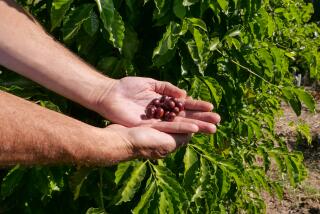Mexican Coffee and Asian Politics
HUATUSCO, Mexico — The steep Sierra Madre mountains here are blanketed with lush, well-tended coffee plants, a testament to the successful efforts of small-scale coffee growers who have defined for themselves a specialized niche in the international marketplace. But there is trouble in these fields. The shrubs are laden with overripe coffee beans rotting on branches.
The peasant farmers of La Union de Huatusco cooperative have good reason to leave their coffee unpicked. Producer prices have plummeted to an all-time low in recent months. Growers who in 2000 could fetch well over a dollar per pound now earn half that amount, making coffee a cruel trade in these hills--and in the rest of the world as well.
There is a strong case to be made that a primary culprit for coffee’s current slump is the communist government of Vietnam. During the 1990s, there was a massive, government-driven expansion of coffee production in Vietnam’s Central Highland provinces. The country has since dumped millions of extra bags (each bag contains 132 pounds) of notably lower-grade coffee on the international market. With world exportable production totaling 80 million bags last year, growers are now producing about 10.5 million more bags than the world’s one billion coffee drinkers want to consume. The result has been a severe price crash for exporting countries like Mexico, where prices have tumbled from $1.34 a pound in 1997 to 52 cents today.
“Who would have thought that the enemy was over in Vietnam?” marvels Jorge Cuevas of RTC International, a coffee company in the poor southern state of Oaxaca, Mexico, that exports premium-quality beans grown high in the mountains, known as “washed” arabicas. In contrast, Vietnam produces lower-grade robusta beans that are used in inexpensive blends and instant coffees. Having tripled production over the past five years, the Southeast Asian country is expected to produce 13 million bags this year, making it the world’s second biggest producer.
The crisis is likely to cost hundreds of thousands of jobs and bankrupt thousands of farms in Latin America and across the developing world. In Mexico, production is expected to fall by as much as 30% this year. Because coffee represents the principal source of income for dozens of countries, producers and policy analysts alike have likened today’s crisis to the Great Depression. What has become apparent to everyone in the coffee business is that, by over-producing and by ignoring the laws of supply and demand, state-dominated economies like Vietnam’s can become big players in a fragile commodity market.
Although painful, the practical solution is to let the current crisis ride, forcing legions of farmers to abandon the industry and learn a new trade. But is that practical? If enough producers leave the market, production will dip and drive prices higher--along with unemployment, crime rates, and civic unrest. In Andean countries, plunging prices have made illegal farming, especially coca production, attractive once again, with out-of-work coffee growers in Colombia seeking steady jobs in coca fields and cocaine laboratories.
The situation is particularly worrisome for Mexico, the world’s fifth largest coffee producer. Mexico has 280,000 growers, most of whom are indigenous, peasant producers. A price crash in the early nineties led many unemployed growers to join the Zapatista uprising. This year, rock-bottom prices have triggered a massive exodus of emigrants to the United States. “My brothers went north to find work months ago,” says Bernardo Palacios, an Union de Huatusco member whose five-acre farm stretches across thick forests. “I should have gone too.”
Circumstances could have been different. Until recently, farmers here had benefited from a surge in consumer demand for “designer coffee” made from washed arabica beans, which are sold at considerably higher prices. From the 1960s to the 1980s, the major roasters--Procter & Gamble (Folgers), Philip Morris (Maxwell House), Nestle (Nescafe), and Sara Lee--fought fiercely for market share on the basis of price rather than quality, thus encouraging use of lower-grade robustas. Because consumers know a bad product when they taste it, coffee steadily lost consumers to Coca-Cola and other caffeinated beverages. In the 1990s, the specialty coffee boom stimulated demand for gourmet, organic, and flavored coffees. Starbucks cafes sprouted across the United States as specialty coffee revenues grew 10 percent annually to $7.9 billion in 2000.
“Tin-can commercial coffee filled with robusta beans had been driving consumers away for years,” says Dave Griswold, president of Sustainable Harvest, a coffee importer in Portland, Ore. “For poor producers, specialty coffee became the gold-laying goose.”
Yet the golden eggs distributed themselves unevenly. Because about 70% of the world’s coffee production is arabica, and roughly 80% of arabica beans grow in Latin America, coffee producers here captured most of the rewards of the specialty craze. Although few farmers got rich, the rise of designer coffee helped revive once-moribund industries in high-mountain coffee countries such as Mexico, Costa Rica, and Guatemala.
For Lucio Cruz Ramirez, a 48-year-old father of nine, coffee has been a difficult life, but one that paid off. Last year, on a four-acre Chiapas farm near La Paz--a two-hour walk from his house--he harvested 2,000 pounds of coffee beans from his 2,750 plants. After partially processing the beans in his back yard, he sold them to local middlemen for a total of $2,100, accounting for 95% of his family’s annual cash income. For this past crop cycle, the same amount of beans would have brought just $1,000. The harsh economic realities have caused six out of 10 growers in La Paz to leave for Tijuana. “May their fortunes change in the factories,” Cruz says, crossing himself.
What’s happening in La Paz and elsewhere in Latin America can be traced, in part, to the World Bank and European bilaterals, which in the ‘90s financed and artificially promoted export-led growth in some of the poorest Asian and African countries. (These countries together produce 80% of world’s robusta beans.) While the specialty American coffee market shunned the lower quality beans, Europeans took advantage of the glut and began using more robustas in their coffee blends, which hurt the market for arabicas. Flush with cash, Vietnam consistently logged 4% to 5% annual agricultural growth, helped along by $300 million of World Bank investments in irrigation, agricultural diversification, rural transport and energy.
The impact on coffee production may not have been direct, but it was substantial. World lending organizations talked about “trade, not aid,” and about stimulating low-cost production and ending market inefficiencies. Yet it was multilateral farm subsidies, not free market forces, that seem to have enabled Vietnam to expand holdings, invest in productive infrastructure, and dramatically increase robusta exports. Ironically, one of the principal losers in the devaluation of coffee is Vietnam, where farmers cannot cover production costs even with dollar-a-day laborers.
So no, this is not a normal supply-demand business cycle. Rather, the rotting beans outside Hanoi and Huatusco reek of a superficially effective but ultimately flawed model of economic growth that ignores the world market. Vietnam subsidized an oversupply of robusta beans at a time when demand for mediocre coffee had been flat for decades. The marketplace was largely ignored at a time when all consumer trends were pointing in the opposite direction. The result is that coffee farming in the third world, once a way out of poverty and involvement with the drug trade, is today a calamitous career for millions of people.
More to Read
Sign up for Essential California
The most important California stories and recommendations in your inbox every morning.
You may occasionally receive promotional content from the Los Angeles Times.










